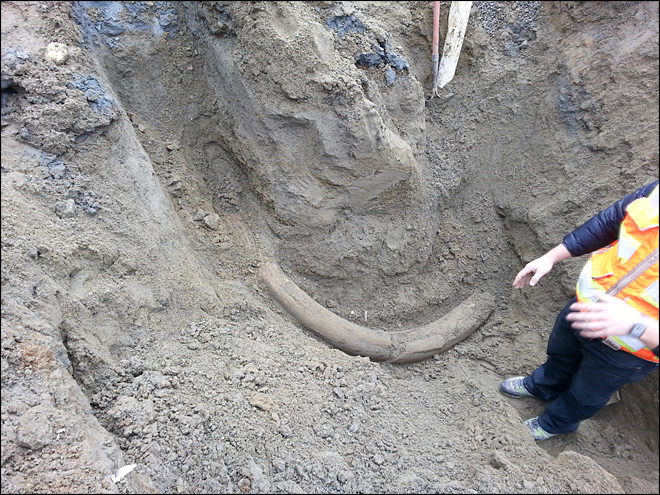
By KOMO Staff Published: Feb 11, 2014 at 5:58 PM PST Last Updated: Feb 12, 2014 at 12:07 PM PST
SEATTLE — An extremely rare piece of history was discovered Tuesday in a South Lake Union construction site. Officials from the Burke Museum confirm that construction workers uncovered a mammoth tusk that appears to date back to the Ice Age. Joe Wells with Transit Plumbing was one of the first workers to spot the object.
“We were like, ‘So, what do we do here?’ You don’t want to damage it or just continue on and tear it out of the ground,” he said.
Bruce Crowley from the University of Washington’s Burke museum went down into the hole to examine the fossil.
“I thought it was a really nice tusk,” he said.
Crowley said the tusk likely came from a Columbian Mammoth – or mastodon, though he said you can’t really tell by looking at it, you would need to do microscopic analysis to determine that.
He said most of the mammoths found in this area, are Columbian Mammoths. There have been similar fossils found in the area, but this one may be the largest.
It’s unclear how the property owner will move forward with the unique find.
“Because the fossil is on private property and does not seem to be associated with an archaeological site, it is up to the landowner to decide what they would like to do with the tusk,” Dr. Christian Sidor of the Burke Museum said in a Tuesday news release.
Sidor said the discovery offers a “rare opportunity to directly study Seattle’s ancient natural history.” The museum has offered to excavate the tusk and provide access to scientists looking to study it. As word of the discovery spread on Tuesday, locals wandered over to the site to get a better look at the tusk.
Monique German, who works at Bright Horizons Childcare Center next door, said the children were excited to get a first-hand look at Seattle history.
“Instantly they went online and started researching wooly mammoths and mastodons and learning how their hair could be 3 feet long and the tusks could be up to 15 feet long,” she said.
German says they’ve already been using the construction project in lesson plans, one day talking with the crane operator on the radio. Another learning all that the foreman does. Now they can add paleontology.
“We found a great children’s book last night that we’re now introducing as part of the curriculum,” German said.
While the kids learn about it, the scientists at the University of Washington want to help excavate it.
“It’s big it’s got nice curvature to it. It seems to be very complete,” said Crowley said.
Crowley says this tusk is likely 16,000 years old and if it’s to be preserved, it needs to be properly excavated. He said right now it’s water logged and if left to dry on its own, Crowley said it will disintegrate. He said the best way to remove it is encase it in plaster it, which would take a day or two, but that way it would be preserved.
The Burke Museum has offered to excavate it and put it on display if the property owner takes that route.
